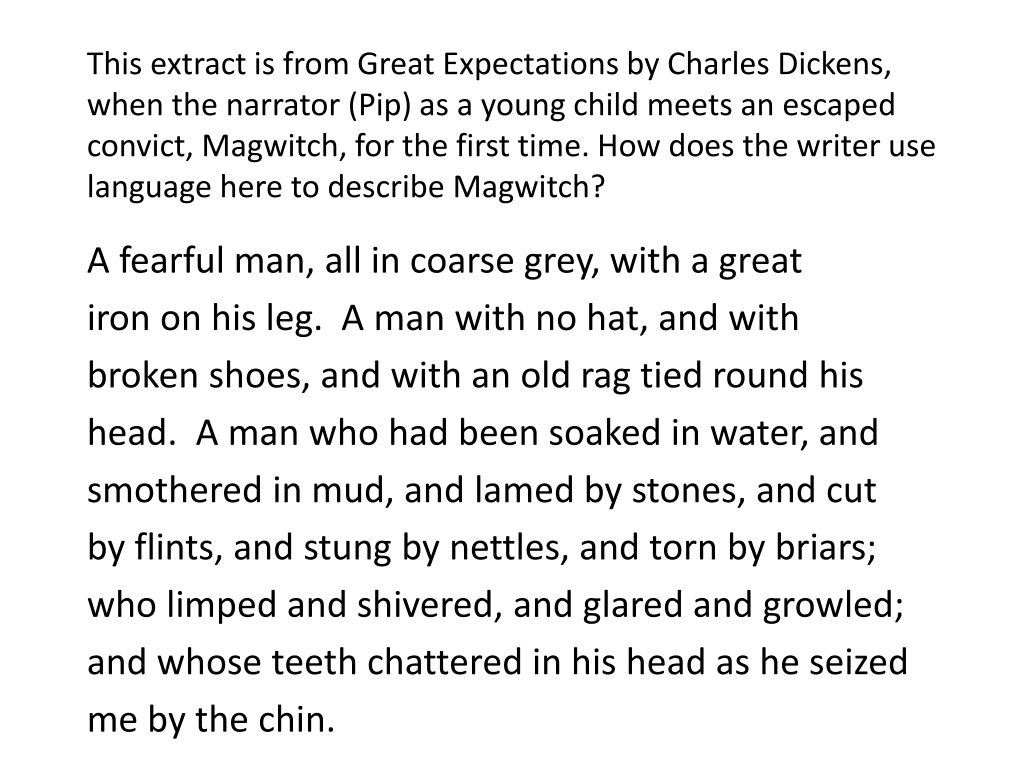Analyzing Description of Magwitch in "Great Expectations
In "Great Expectations" by Charles Dickens, the writer uses descriptive language to introduce Magwitch, an escaped convict, as a fearful yet pitiful figure through detailed noun phrases. This analysis explores the mixed emotions evoked by Magwitch's portrayal, inviting readers to consider whether to feel frightened or sympathetic towards him.
Download Presentation

Please find below an Image/Link to download the presentation.
The content on the website is provided AS IS for your information and personal use only. It may not be sold, licensed, or shared on other websites without obtaining consent from the author. Download presentation by click this link. If you encounter any issues during the download, it is possible that the publisher has removed the file from their server.
E N D
Presentation Transcript
This extract is from Great Expectations by Charles Dickens, when the narrator (Pip) as a young child meets an escaped convict, Magwitch, for the first time. How does the writer use language here to describe Magwitch? A fearful man, all in coarse grey, with a great iron on his leg. A man with no hat, and with broken shoes, and with an old rag tied round his head. A man who had been soaked in water, and smothered in mud, and lamed by stones, and cut by flints, and stung by nettles, and torn by briars; who limped and shivered, and glared and growled; and whose teeth chattered in his head as he seized me by the chin.
Supporting linguistic analysis Students often have real difficulty in answering What is the effect of ? and this kind of understanding needs careful scaffolding. It can be helpful to use prompts that tie to a purpose or that name the effect e.g. In this first meeting, Magwitch is a frightening figure for Pip yet the reader also has sympathy for the convict. Look at how Dickens uses noun phrases to describe Magwitch and create this mixed picture. Why do you think he wants us to see Magwitch in this way? Think about framing your questions to offer this kind of support and about withdrawing that support over time to enable independence.
Supporting linguistic analysis Look at the way Magwitch is described when we first meet him in Great Expectations. Should we be frightened by him or should we have sympathy for him? A fearful man, all in coarse grey, with a great iron on his leg. A man with no hat, and with broken shoes, and with an old rag tied round his head. A man who had been soaked in water, and smothered in mud, and lamed by stones, and cut by flints, and stung by nettles, and torn by briars; who limped and shivered, and glared and growled; and whose teeth chattered in his head as he seized me by the chin.
Look at the way Magwitch is described when we first meet him in Great Expectations. Should we be frightened by him or should we have sympathy for him? Sort the noun phrases into those that make him sound frightening and those that make him sound a pitiful victim. A fearful man, all in coarse grey, with a great iron on his leg. A man with no hat, and with broken shoes, and with an old rag tied round his head. A man who had been soaked in water, and smothered in mud, and lamed by stones, and cut by flints, and stung by nettles, and torn by briars; who limped and shivered, and glared and growled; and whose teeth chattered in his head as he seized me by the chin.
Look at the way Magwitch is described when we first meet him in Great Expectations. Should we be frightened by him or should we have sympathy for him? Sort the noun phrases into those that make him sound frightening and those that make him sound a pitiful victim. A A fearful fearful man his leg his leg. A A man and with an old rag tied round his head and with an old rag tied round his head. A man had been soaked in water, and smothered in mud, had been soaked in water, and smothered in mud, and lamed by stones, and cut by flints, and stung by and lamed by stones, and cut by flints, and stung by nettles, and torn by briars; who limped and shivered nettles, and torn by briars; who limped and shivered, and glared and growled glared and growled; and whose teeth chattered in his head in his head as he seized me by the chin. as he seized me by the chin. man, all in coarse grey, with a great iron on all in coarse grey, with a great iron on man with no hat, and with broken shoes, with no hat, and with broken shoes, A man who who whose teeth chattered
This extract is from Great Expectations by Charles Dickens, when the narrator (Pip) as a young child meets an escaped convict, Magwitch, for the first time. How does the writer use language here to describe Magwitch? A fearful man, all in coarse grey, with a great iron on his leg. A man with no hat, and with broken shoes, and with an old rag tied round his head. A man who had been soaked in water, and smothered in mud, and lamed by stones, and cut by flints, and stung by nettles, and torn by briars; who limped and shivered, and glared and growled; and whose teeth chattered in his head as he seized me by the chin.
You are going to enter a creative writing competition. Your entry will be judged by a panel of people of your own age. Choose one of these people to write about. Write a description of your chosen character that shows what kind of person they are and how you react to them.






![Read⚡ebook✔[PDF] Life in the Universe: Expectations and Constraints (Springer P](/thumb/21626/read-ebook-pdf-life-in-the-universe-expectations-and-constraints-springer-p.jpg)

















